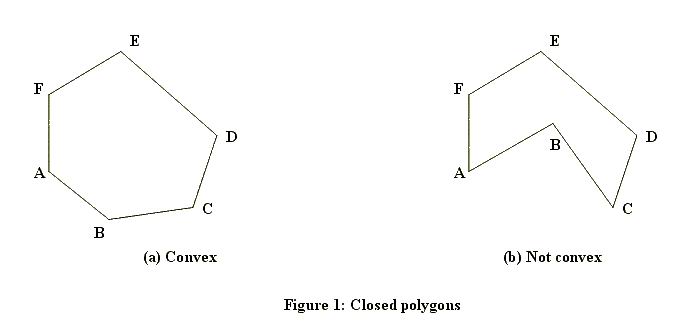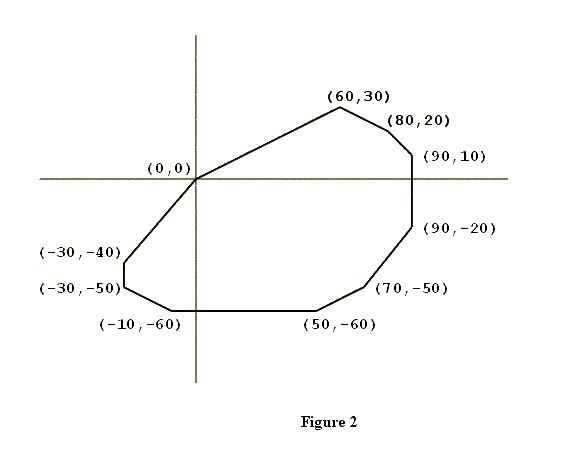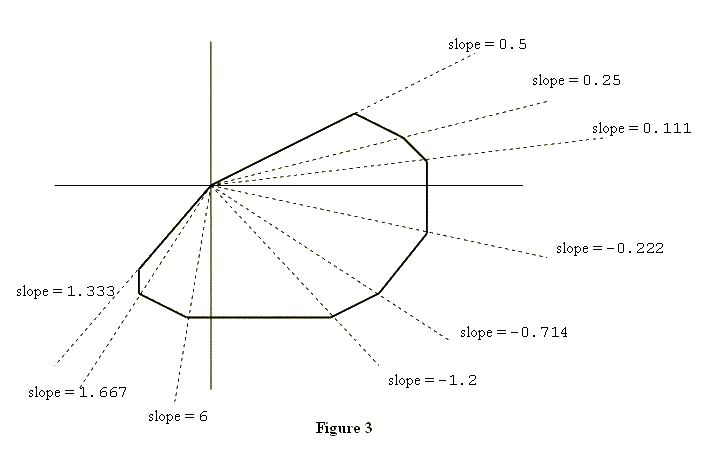POJ 2007 Scrambled Polygon [凸包 极角排序]
| Time Limit: 1000MS | Memory Limit: 30000K | |
| Total Submissions: 8636 | Accepted: 4105 |
Description
A closed polygon is called convex if the line segment joining any two points of the polygon lies in the polygon. Figure 1 shows a closed polygon which is convex and one which is not convex. (Informally, a closed polygon is convex if its border doesn't have any "dents".) 
The subject of this problem is a closed convex polygon in the coordinate plane, one of whose vertices is the origin (x = 0, y = 0). Figure 2 shows an example. Such a polygon will have two properties significant for this problem.
The first property is that the vertices of the polygon will be confined to three or fewer of the four quadrants of the coordinate plane. In the example shown in Figure 2, none of the vertices are in the second quadrant (where x < 0, y > 0).
To describe the second property, suppose you "take a trip" around the polygon: start at (0, 0), visit all other vertices exactly once, and arrive at (0, 0). As you visit each vertex (other than (0, 0)), draw the diagonal that connects the current vertex with (0, 0), and calculate the slope of this diagonal. Then, within each quadrant, the slopes of these diagonals will form a decreasing or increasing sequence of numbers, i.e., they will be sorted. Figure 3 illustrates this point. 

Input
Output
Sample Input
0 0
70 -50
60 30
-30 -50
80 20
50 -60
90 -20
-30 -40
-10 -60
90 10
Sample Output
(0,0)
(-30,-40)
(-30,-50)
(-10,-60)
(50,-60)
(70,-50)
(90,-20)
(90,10)
(80,20)
(60,30)
Source
显然极角排序 用叉积 但WA好多次最后发现必须要保证第一个点在开始,排序直接跳过就行了
#include <iostream>
#include <cstdio>
#include <cstring>
#include <algorithm>
#include <cmath>
using namespace std;
typedef long long ll;
const int N=;
const double eps=1e-; inline int read(){
char c=getchar();int x=,f=;
while(c<''||c>''){if(c=='-')f=-; c=getchar();}
while(c>=''&&c<=''){x=x*+c-''; c=getchar();}
return x*f;
} inline int sgn(double x){
if(abs(x)<eps) return ;
else return x<?-:;
} struct Vector{
double x,y;
Vector(double a=,double b=):x(a),y(b){}
};
typedef Vector Point;
double Dot(Vector a,Vector b){return a.x*b.x+a.y*b.y;}
double Cross(Vector a,Vector b){return a.x*b.y-a.y*b.x;} int n,x,y;
Point p[N],S;
bool cmpPolar(Point a,Point b){
return sgn(Cross(a,b))>;
}
int main(int argc, const char * argv[]) {
while(scanf("%d",&x)!=EOF){
y=read();
p[++n]=Point(x,y);
}
sort(p+,p++n,cmpPolar);
for(int i=;i<=n;i++) printf("(%.0f,%.0f)\n",p[i].x,p[i].y);
return ;
}
#include <iostream>
#include <cstdio>
#include <cstring>
#include <algorithm>
#include <cmath>
#include <vector>
using namespace std;
typedef long long ll;
const int N=;
const double eps=1e-;
const double pi=acos(-); inline int read(){
char c=getchar();int x=,f=;
while(c<''||c>''){if(c=='-')f=-; c=getchar();}
while(c>=''&&c<=''){x=x*+c-''; c=getchar();}
return x*f;
} inline int sgn(double x){
if(abs(x)<eps) return ;
else return x<?-:;
} struct Vector{
double x,y;
Vector(double a=,double b=):x(a),y(b){}
bool operator <(const Vector &a)const{
//return x<a.x||(x==a.x&&y<a.y);
return sgn(x-a.x)<||(sgn(x-a.x)==&&sgn(y-a.y)<);
}
};
typedef Vector Point;
Vector operator +(Vector a,Vector b){return Vector(a.x+b.x,a.y+b.y);}
Vector operator -(Vector a,Vector b){return Vector(a.x-b.x,a.y-b.y);}
Vector operator *(Vector a,double b){return Vector(a.x*b,a.y*b);}
Vector operator /(Vector a,double b){return Vector(a.x/b,a.y/b);}
bool operator ==(Vector a,Vector b){return sgn(a.x-b.x)==&&sgn(a.y-b.y)==;} double Dot(Vector a,Vector b){return a.x*b.x+a.y*b.y;}
double Cross(Vector a,Vector b){return a.x*b.y-a.y*b.x;}
double DisPP(Point a,Point b){
Point t=b-a;
return sqrt(t.x*t.x+t.y*t.y);
}
int ConvexHull(Point p[],int n,Point ch[]){//cannot handle repeat point
sort(p+,p++n);
int m=;
for(int i=;i<=n;i++){
while(m>&&sgn(Cross(ch[m]-ch[m-],p[i]-ch[m-]))<=) m--;
ch[++m]=p[i];
}
int k=m;
for(int i=n-;i>=;i--){
while(m>k&&sgn(Cross(ch[m]-ch[m-],p[i]-ch[m-]))<=) m--;
ch[++m]=p[i];
}
if(n>) m--;//the first point
return m;
}
int n,x,y;
double ans;
Point p[N],ch[N];
int main(int argc, const char * argv[]) {
while(scanf("%d",&x)!=EOF){
y=read();
p[++n]=Point(x,y);
}
ConvexHull(p,n,ch);
Point S(,);int p;
for(p=;p<=n;p++) if(ch[p]==S) break; for(int i=p;i<=n;i++) printf("(%.0f,%.0f)\n",ch[i].x,ch[i].y);
for(int i=;i<p;i++) printf("(%.0f,%.0f)\n",ch[i].x,ch[i].y);
return ;
}
POJ 2007 Scrambled Polygon [凸包 极角排序]的更多相关文章
- poj 2007 Scrambled Polygon(极角排序)
http://poj.org/problem?id=2007 Time Limit: 1000MS Memory Limit: 30000K Total Submissions: 6701 A ...
- POJ 2007 Scrambled Polygon 凸包点排序逆时针输出
题意:如题 用Graham,直接就能得到逆时针的凸包,找到原点输出就行了,赤果果的水题- 代码: /* * Author: illuz <iilluzen[at]gmail.com> * ...
- POJ 2007 Scrambled Polygon 凸包
Scrambled Polygon Time Limit: 1000MS Memory Limit: 30000K Total Submissions: 7214 Accepted: 3445 ...
- 简单几何(极角排序) POJ 2007 Scrambled Polygon
题目传送门 题意:裸的对原点的极角排序,凸包貌似不行. /************************************************ * Author :Running_Time ...
- POJ 2007 Scrambled Polygon(简单极角排序)
水题,根本不用凸包,就是一简单的极角排序. 叉乘<0,逆时针. #include <iostream> #include <cstdio> #include <cs ...
- POJ 2007 Scrambled Polygon (简单极角排序)
题目链接 题意 : 对输入的点极角排序 思路 : 极角排序方法 #include <iostream> #include <cmath> #include <stdio. ...
- poj 2007 Scrambled Polygon 极角排序
/** 极角排序输出,,, 主要atan2(y,x) 容易失精度,,用 bool cmp(point a,point b){ 5 if(cross(a-tmp,b-tmp)>0) 6 retur ...
- POJ 2007 Scrambled Polygon 极角序 水
LINK 题意:给出一个简单多边形,按极角序输出其坐标. 思路:水题.对任意两点求叉积正负判断相对位置,为0则按长度排序 /** @Date : 2017-07-13 16:46:17 * @File ...
- ●POJ 2007 Scrambled Polygon
题链: http://poj.org/problem?id=2007 题解: 计算几何,极角排序 按样例来说,应该就是要把凸包上的i点按 第三像限-第四像限-第一像限-第二像限 的顺序输出. 按 叉积 ...
随机推荐
- GO开发[四]:golang函数
函数 1.声明语法:func 函数名 (参数列表) [(返回值列表)] {} 2.golang函数特点: a. 不支持重载,一个包不能有两个名字一样的函数 b. 函数是一等公民,函数也是一种类型,一个 ...
- c# base 和this 继承
父类的构造函数总是在子类之前执行的.既先初始化静态构造函数,后初始化子类构造函数. public class BaseCircle { public BaseCircle() { Console.Wr ...
- ip001
----------- <?phpheader('Content-type:text/html;charset=utf8');// <script type="text/java ...
- OOAD之策略模式(1)
在引入策略模式之前.先用一个小项目解释为什么要有策略模式.这是一个模拟鸭子的小游戏.最开始需求为,所有的鸭子都会叫以及都会游泳且叫声游泳姿势都一样.因此我们用原始OO的思维去编写代码时很容易做到 pu ...
- Codeforces 900D Unusual Sequences 容斥原理
题目链接:900D Unusual Sequences 题意: 给出两个数N,M.让你求数列(和为M,gcd为N)的个数. 题解: 首先,比较容易发现的是M%N如果不为零,那么一定不能构成这样的序列 ...
- shopnc IM配置过程
im配置windows下,修改chat下和data下的config,安装node,覆盖node下文件即可
- 查看 Apache并发请求数及其TCP连接状态【转】
查看 Apache并发请求数及其TCP连接状态 (2011-06-27 15:08:36) 服务器上的一些统计数据: 1)统计80端口连接数netstat -nat|grep -i "80& ...
- 关于手残,搞废我的OLED屏幕的 追悼会
2017-12-1913:36:41 昨天按照B站的资料利用esp12F做了一个天气站,可预报天气,惭愧的是模型做好了,照片还没拍就夭折了,可怜了我20块的屏幕,我心伤悲,莫知我哀呀! 本来调试已经成 ...
- python_将多个小字符拼接成大字符?
案例: 下面有一个列表,如何把这个列表拼接成一个字符串? l = [1, 2, 3, 4, 'a', 'b', 'c'] 有哪些方法? 方法1: for进行迭代拼接 #!/usr/bin/python ...
- 【转】shell字符串截取
shell字符串的截取的问题: 一.Linux shell 截取字符变量的前8位,有方法如下: 1.expr substr “$a” 1 8 2.echo $a|awk ‘{print substr( ...
